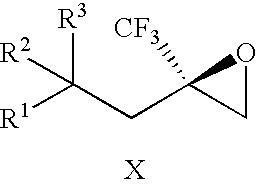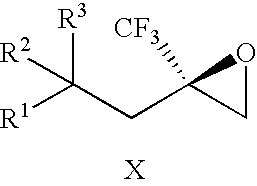Stereoselective synthesis of certain trifluoromethyl-substituted alcohols
a trifluoromethyl and alcohol technology, applied in the field of selective synthesis of certain trifluoromethylsubstituted alcohols, can solve the problems of unsuitable chiral hplc and other enantiomer separation methods, general unsuitability for large-scale preparation of single enantiomer, and low conversion rate,
- Summary
- Abstract
- Description
- Claims
- Application Information
AI Technical Summary
Benefits of technology
Problems solved by technology
Method used
Image
Examples
experimental examples
[0088] The invention provides processes for making compounds of Formula (I). In all schemes, unless specified otherwise, R1 to R5 in the formulas below can have the meanings of R1 to R5 in the Trifluoromethyl-Substituted Alcohol Patent Applications. Intermediates used in the preparation of compounds of the invention are either commercially available or readily prepared by methods known to those skilled in the art. For example, 2-(2-chloro-1,1-dimethylethyl)-4-fluoro-1-methoxybenzene was synthesized by heating a mixture of 4-fluoroanisole, methallyl chloride, and sulfuric acid at 50° C.
[0089] The epoxide of Formula (II) is a key intermediate in the synthesis of certain racemic compounds of Formula (I), as described in U.S. patent application Pub. No. 2004 / 0162321 (corresponding to PCT International Publication No. WO 2004 / 063163), which is hereby incorporated by reference. Treatment of the epoxide of Formula (II) with the nucleophile R5H, in the presence of base opens the epoxide to...
example 1
Synthesis of (R)-2-[2-(5-fluoro-2-methoxyphenyl)-2-methylpropyl]-2trifluoromethyloxiran
[0093]
[0094] Magnesium turnings (46 g, 1.89 mol) were placed in a 5000 mL three-neck flask equipped with a mechanical stirrer and an additional funnel. The flask was heated to 120° C. under vacuum and then flushed with nitrogen while cooling to ambient temperature. This procedure was repeated three times, then the flask was cooled to ambient temperature and kept under a constant nitrogen blanket. Anhydrous diethyl ether (1000 mL) was added and the mixture was stirred at approximately 260 rpm. Dibromoethane (86.25 g, 0.46 mol) was added to the mixture through the addition funnel over about 1 hour while the temperature was kept between 22° C. and 27° C. The addition of dibromoethane to the flask was exothermic and water cooling was applied to maintain this temperature range.
[0095] 2-(2-Chloro-1,1-dimethylethyl)-4-fluoro-1-methoxybenzene (100 g, 0.46 mol) and dibromoethane (86.25 g, 0.46 mol) were ...
example 2
Asymmetric Trifluoromethyl Addition to Alkyl Substituted Ketoester
[0105]
[0106] Using the trans-2-phenyl-1-cyclohexanol as the auxiliary, we have demonstrated that an alkyl substituted ketoester also underwent auxiliary-controlled asymmetric trifluoromethyl addition.
PUM
 Login to View More
Login to View More Abstract
Description
Claims
Application Information
 Login to View More
Login to View More - R&D
- Intellectual Property
- Life Sciences
- Materials
- Tech Scout
- Unparalleled Data Quality
- Higher Quality Content
- 60% Fewer Hallucinations
Browse by: Latest US Patents, China's latest patents, Technical Efficacy Thesaurus, Application Domain, Technology Topic, Popular Technical Reports.
© 2025 PatSnap. All rights reserved.Legal|Privacy policy|Modern Slavery Act Transparency Statement|Sitemap|About US| Contact US: help@patsnap.com



